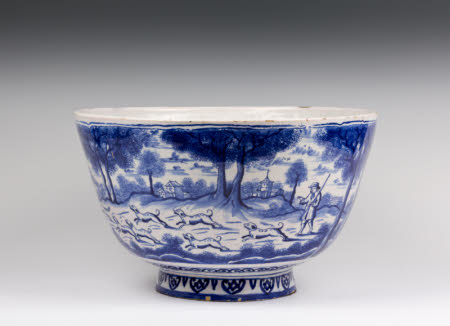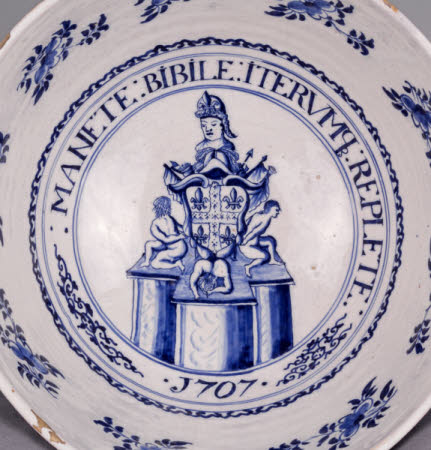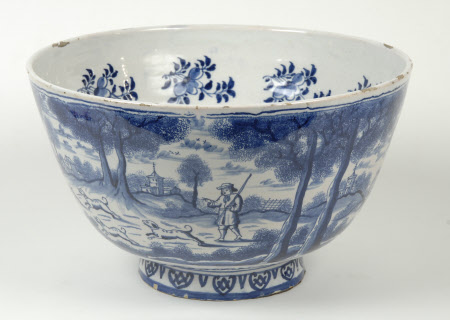Punch bowl
Christian Wilhelm (d.1630)
Category
Ceramics
Date
1707
Materials
Tin-glazed earthenware
Measurements
215 mm (Height); 355 mm (Diameter)
Place of origin
Southwark
Order this imageCollection
Kingston Lacy Estate, Dorset
NT 1250634
Summary
A punch bowl, blue-and-white delft, made in Lambeth, dated 1707. Deep and with low foot. The exterior painted with a fox-hunting scene amidst a continuous landscape of sponged trees. The interior painted with the arms and crest of Bankes before a display of martial trophines and with three supporting naked figures, all atop a pillar. Within a border bearing the inscription ': MANETE : BIBILE : ITERUMQUE : REPLETE :' (translation - 'Stay oh Drinker and fill it up again), and the date '.1707.', within a border of sprays of flowering branches.
Full description
This is a rare punchbowl, and is thought to be an early depiction of fox hunting. It is one of the the few objects at Kingston Lacy surviving from the time of John Bankes the Elder (1665-1714). Note on Heraldry: The head of a black person – sometimes crowned, sometimes ‘wreathed’ about the head – appears frequently as a motif (or charge) in medieval European heraldry. In the language of heraldry, the person depicted is described (or blazoned) as a ‘maure’, ‘moor’, ‘blackmoor’ or ‘blackamoor’, and the motif as ‘a maure’s head’ or ‘a moor’s head’, and so on. The term ‘maure’ derives from the Greek work ‘mauros’ meaning ‘black’ or ‘very dark’ and, in the medieval and early modern periods, was an ill-defined stereotype applied to Muslims of the Islamic Iberian Peninsula and North Africa. Usage developed to conflate Muslims of any ethnicity with black Sub-Saharan Africans. The image of the ‘moor’ or ‘blackamoor’ in European heraldry is itself usually stereotyped. Precisely when and where this motif was adopted as an heraldic charge is unknown, but the earliest example is thought to date from 11th century Italy. Its origins may lie in the invasion of Spain and Portugal in 711 by Africa and Arab Muslim forces. In Western Europe, the device may have referred to the black Egyptian St. Maurice, the patron saint of the Holy Roman Empire from the beginning of the 10th century, or to denote participation in the Crusades. Sometimes, in England, the device is used in what are known as ‘canting’ arms, and are incorporated into the arms of a family called ‘More’ or ‘More’, as a pun on their name. Several National Trust properties were, at one time in their history, owned by families whose coats of arms and/or crests incorporated ‘a moor’s head’ as an heraldic charge, and so it appears on objects which survive in National Trust collections. The arms of the Bankes family of Kingston Lacy, for instance, granted in 1613, included the crest ‘a moor’s head, full-faced, couped at the shoulders proper, on the head a cap of maintenance gules, turned up ermine, adorned with a crescent, issuant therefrom a fleur-de-lis or’. ‘Moors’ heads’ also featured in the arms of the Watt family, slave-traders and owners of several Jamaican plantations, who bought Speke Hall in 1795 and who set up their arms in stained glass in one of the windows there. The term ‘moor’ is now considered anachronistic, but it remains part of heraldry’s descriptive vocabulary. It is used here in its historical and heraldic context.
Provenance
Bequest of the estates of Corfe Castle and Kingston Lacy made to the National Trust by Henry John Ralph Bankes (1902-1981). National Trust ownership commenced on 19 August 1982.
Marks and inscriptions
Inside bottom of bowl: 'MANETE BIBILE ITERVM [Q] REPLETE 1707' (stay oh drinker and fill it up again) Crest and coat of arms of Bankes
Makers and roles
Christian Wilhelm (d.1630), potter


